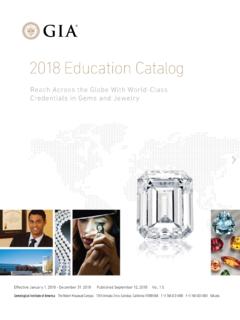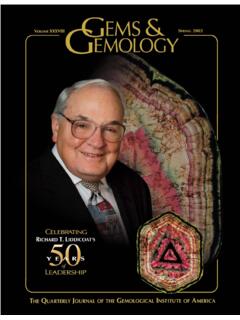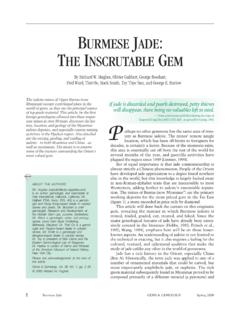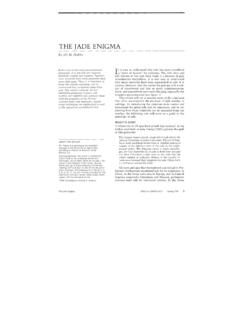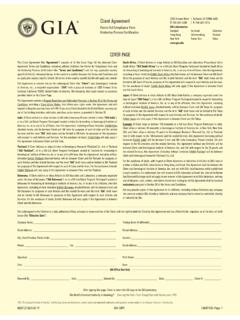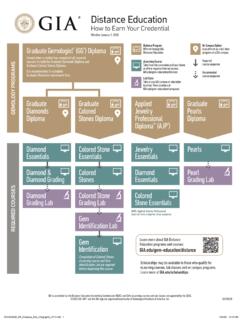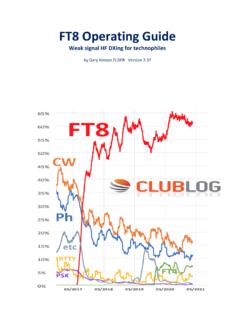Transcription of Modern Diamond Cutting and Polishing
1 102 Modern Diamond CuttingGEMS & GEMOLOGYS ummer 1997 ABOUT THE AUTHORMr. Caspi, an electronics engineer, is generalmanager of Advanced Diamond Technology Ltd.,Holon, Israel (fax: 972-3-5595139; As a member of the IsraelDiamond Institute in Ramat-Gan from 1987 to1997, he was closely involved in adapting moderntechnological manufacturing procedures andequipment to the process of Cutting gem : The author thanks Dr. JamesE. Shigley of GIA Research for his dedication andassistance in the preparation of this & Gemology, Vol. 33, No. 2, pp. 102 121 1997 Gemological Institute of AmericaThis article examines the sophisticatedtechniques and equipment currently usedto fashion a polished gem from a roughdiamond. The basic manufacturing tech-niques sawing, bruting, blocking, andpolishing are described with regard tothe decisions that must be made to obtainthe greatest value from a specific piece ofrough.)
2 Over the last 25years, the dia-mond- Cutting industry worldwide hasbeen revolutionized by sophisticatedinstruments for marking, laser sawingmachines, laser kerfing machines, auto-matic bruting machines and laser brutingsystems, automatic centering systems,and automatic Polishing many, a rough Diamond looks like any transpar-ent crystal or even a piece of broken glass. Whencut as a faceted gemstone, however, it becomes asparkling, shimmering object that is unique in most of the people who are involved with gem dia-monds jewelers, gemologists, and the jewelry-buying pub-lic are unfamiliar with many of the details involved in thattransformation (figure 1).The manufacturing of gem-quality diamonds hasadvanced more since 1980 than in the preceding 100 the past two decades, a quiet revolution has takenplace in much of the Diamond -manufacturing industry.
3 Byadapting computer-imaging techniques, precision measure-ment systems, lasers, and other Modern technologicalequipment, many manufacturers have improved their abili-ty to cut gem diamonds in ways unimaginable only a fewshort years before. A significant result of this revolution is adiamond industry that is now better able to operate prof-itably. In addition, Modern manufacturers can handle roughdiamonds that would have been difficult, if not impossible,to cut by traditional manufacturing article has two purposes. The first is to describethis technological revolution by discussing the key steps inthe manufacturing process and describing the recent techno-logical improvements that have been made at each this article is based primarily on the author sexperience in the Israeli Diamond industry over the last 10years, most of the advanced technology discussed can nowbe found in major manufacturing centers worldwide.
4 Thesecond purpose is to discuss the critical decisions that amanufacturer must make during the Cutting process toobtain the maximum value from the finished manufacture of a Diamond into a faceted gemstone (fig-ure 2) presents some very special challenges, including:1. As the hardest known substance (10 on the MohsTMODERNDIAMONDCUTTINGANDPOLISHINGBy Akiva CaspiModern Diamond CuttingGEMS & GEMOLOGYS ummer 1997103scale), Diamond is also one of the most diffi-cult gem materials to Although Diamond is optically isotropic( , it has only one refractive index), itshardness varies with crystallographic orien-tation, such that it can only be polished incertain crystallographic directions. Thesedirections have traditionally been referredto as the grain (see, , Vleeschdrager,1986, p. 37).3. The Cutting process seeks to take advantageof the critical angle of total light reflectionwithin the faceted Diamond to achieve themaximum amount of light return throughthe crown facets.
5 Diamond has a very highrefractive index ( ), and a mathematicalbasis for the shape and facet arrangement ofthe round brilliant cut was establishedearly in this century by M. Tolkowsky(1919). Today, many other Cutting stylesare also used, including a variety of fancycuts (see G. Tolkowsky, 1991).4. The differences between the various colorand clarity grades for faceted diamonds canbe quite subtle, and very slight variations incutting style and weight retention canresult in significant differences in of these challenges must be addressedthroughout the Cutting process. Today, as it has fordecades, gem Diamond manufacturing involves thefollowing basic steps:1. Selecting (or sorting) the Diamond includes examining each Diamond forits potential color grade, clarity grade, andcutting Marking the rough for 1. The Cutting pro-cess is critical to thetransformation of a dia-mond from a simple crys-tal to a brilliant facetedgem in a beautiful pieceof jewelry.
6 The faceteddiamonds in these con-temporary rings rangefrom ct for thesmallest oval to ctfor the largest of Hans , Idar-Oberstein,Germany; photo Harold & Erica Van Diamond CuttingGEMS & GEMOLOGYS ummer 19973. Cleaving and/or sawing the rough Bruting the Polishing the large diamonds, some of these steps are repeateda number of times, for example: sawing tablepolishing bruting blocking ( Polishing four oreight facets) [repolishing the table rebruting provisional Polishing (8 facets)] final tablepolishing final bruting final Polishing . Thiscomes from a constant effort to improve the finalappearance of the stone and the yield from therough. The conventional means of manufacturingdiamonds, and the various Cutting styles used, havebeen described in several texts, including those ofBruton (1981), Watermeyer (1991, 1994), Ludel(1985), Vleeschdrager (1986), and Tillander (1995).
7 The goal in Cutting a rough Diamond is to maxi-mize the market value of the faceted stone or stonesproduced from that piece of rough. This value isbased on the well-known 4 Cs: Carat weight, Color,Clarity, and the less easily evaluated Cut. To illus-trate, figure 3 shows where Diamond manufacturingtakes place on what can be thought of as an eco-nomic conveyor belt. In this figure, the assump-tion is made that the final selling price of a cut dia-mond in a piece of jewelry is $100. Before the dia-mond is mined, it has no value ($0). When the origi-nal piece of rough is discovered in the mine, extract-ed from the host rock, and sorted, it has an estimat-ed value of $26. The cut Diamond is sold to the jew-elry manufacturer for $30, and then to the retailjeweler for $50. Thus, in this example, one sees thatthe manufacturer s component is only $2, a verysmall percentage of the total retail value (but about7% of the price of the loose Diamond as it is sold tothe trade).
8 Typically, the actual profit would repre-sent only about of the value of the cut stonein a finished piece of jewelry about 50 cents in a second example of this same idea, assumethat a ct faceted Diamond will sell at retail for$4,500 when set in a standard ring, that the roughdiamond was sold to the manufacturer for about$1,170, and that after Cutting its value was $1, $90 window for the manufacturer must beenough to cover the cost of production, capitalinvestment, risks (some diamonds are damaged dur-ing Cutting ), and profit. To ensure profit, therefore,the manufacturer has to be very efficient when hecuts the Diamond . As will be illustrated later in thisarticle, minor errors in Diamond manufacturing cancause major losses in the mid-1980s, the Israel Diamond Institutewas one of a few groups in the international dia-mond industry that made a conscious decision topursue the use of sophisticated technology in thelocal manufacturing sector.
9 The Israeli industry atthat time was based largely on conventional meth-ods. Earlier attempts to introduce automatic polish-ing machines had not been totally successful,because the manufacturers lacked not only theknowledge but also any understanding of the avail-able both that the Israeli Diamond -man-ufacturing industry was very conservative and thatthe sophisticated techniques used in other indus-tries could not readily be applied to the problems ofcutting diamonds, the institute s engineer first ana-lyzed the processes and established which areaswould benefit most from technological , new manufacturing methods were intro-duced, including computer-aided evaluation of therough crystals, lasers for precision sawing, automat-Figure 2. Many decisionsare required to turn arough Diamond like themacle on the left into afine triangular brilliant-cut Diamond like thestone on the far of Kleinhaus,New York; photo Harold& Erica Van bruting and Polishing equipment, and computerimaging for more accurate measurement of the pol-ished stones.
10 These changes have resulted in signifi-cant improvements in the manufacturing process,and have been adopted throughout the Israeli indus-try and in other Cutting centers such as introduction of new manufacturing tech-nologies is ongoing, with much effort currentlyunder way to educate other Diamond manufacturerson how to use these technologies effectively in theirown facilities. Since these efforts are still relativelynew, few articles describing them have appeared inthe trade press (see, , Lawrence, 1996). At pre-sent, the best source of information is the proceed-ings volume published following the October 1991 International Technical Symposium sponsored bythe De Beers Central Selling Organisation (CSO) inTel Aviv, Israel (Cooke and Caspi, 1991). Accordingto Lawrence (1991, p. 1 3) in this proceedings vol-ume, there are many important benefits to usingmodern technology for Diamond manufacturing:1.
